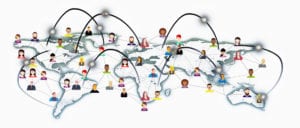No matter where we live – we can change the world.
In 2008 well-known physicist David Peat wrote a beautiful book titled Gentle Action: Bringing Creative Change to a Turbulent World. I like this book a lot because he shares a perspective on how to influence system change based on the assumption that the system is interdependent. While this shift may appear subtle, in fact it changes everything. We’ve seen examples time and time again demonstrate that when many people act interdependently in a common direction, they can completely transform the system over time. Before that change can happen, however, we have to start with the understanding that our connections enhance the impact of our individual actions. We have to create a new point of view.
A second idea from Peat’s book is that in an interdependent world we must reflect on ourselves and how our own actions may contribute to the problem. A hierarchical approach to change starts at the top of the organization. In this traditional paradigm, organizational leaders initiate change by assuming that “others” are the problem, never examining how their own thinking, actions, or processes contribute to the issue. As we learned last week, this idea of creating change only from the top is a myth we need to release to embrace a systems thinking, or living systems, perspective.
With David Peat’s thinking flowing through my brain, I have been reflecting on three ways we, as individuals, can act in a common direction to influence and transform the world. Here are my thoughts:
- Amplify connections and interdependence. In his book, The Honest Truth About Dishonesty: How We Lie to Everyone–Especially Ourselves, behavioral economist Dan Ariely found that the more separation a person has from the system, the more self-interested and greedier their behavior becomes. This finding made me ask the question “How can I accelerate connections and interdependence in my daily life and consulting work?” This is particularly important now when we need to be thinking from a one planet perspective.
If connection to the overall system can reduce self-interest, amplifying connection could be an important act to help our thinking and actions.
- Increase our time horizon. So many of the decisions that have led to a degenerating system evidenced by a loss of biodiversity, increased pollution, rising carbon emissions, and other global impacts have been anchored in a short-term return on investment. And yet Nature is a long-term regenerative system. It supports the life of future generations. Through five mass extinctions, it has regenerated life each time. This leads me to ask “How can I work with clients to extend their time horizon when making decisions?” For example, I have a client heavily engaged in organizational change as they try to meet some ambitious 2030 sustainability goals. One thinking habit they have is to assess sustainable decisions based on a three-year ROI. This artificial short-term timeline encourages decisions that create obstacles to meeting their 2030 sustainability goals. . By extending the ROI to 5-7 years (or more), many more projects get green-lighted that make their goals much more achievable, and in turn help save the planet.
- Accelerate networking around purpose to unleash self-organization. People who know there is a better way to organize our economy, whether they’re considering implementing a triple bottom line, or reinventing themselves vis a vis green/blue/circular economies, for example, often find their work discouraging because it is so daunting. Knowing there are millions of people around the world who are doing their own part to shift these systems can help us feel less lonely in this important work. The more people doing this work come together, and the more networks we create around this purpose, the more we can unleash the self-organizing behavior we have inside all of us. And that gives us hope that we can more readily influence the change we want to see.
I am working with an organization to create a massive database of groups, institutions, and people who are engaged in sustainability, regenerative, and green economies redesign. The plan is to map this database, so people working across the world can see who is doing this work in their location. They can then self-organize collaborations to amplify their voice and their work. Nature runs an adaptive cycle that constantly renews and innovates itself through purpose and the unleashing of self-organization. It is a highly effective evolving system.
Nature looks at the smallest act that can use the natural interdependence of the system to bring the system back into dynamic health. These are the three ways I believe I can change the world, by bringing more intentionality into my localized actions and work.







Thank you. Thinking about “3. Accelerate networking around purpose to unleash self-organization.” Want to explore further.
I align with your words totally – thanks for sharing your insights and questions Kathy.
I really like the accelerating networks idea
Count me in. Peter Paul Leutscher RedZebraGtoup